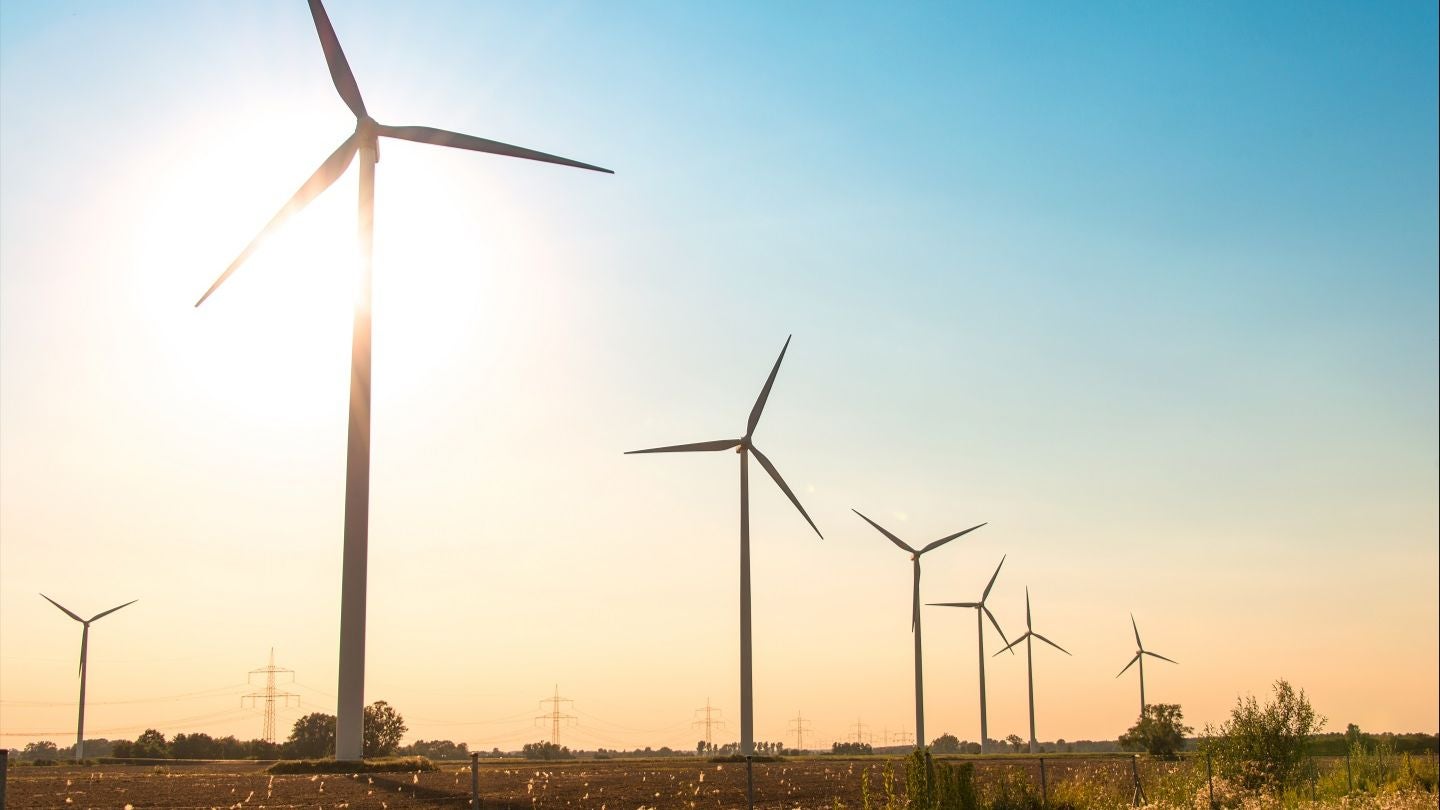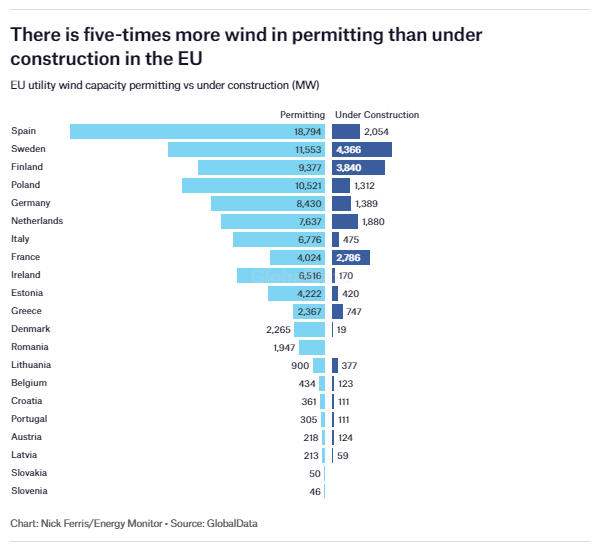
Building local buy-in for renewable energy projects is essential for the successful deployment of wind and solar projects. In Germany, six times more renewables projects are stuck in permitting than there are under construction, in large part due to local opposition, according to analytics company GlobalData[1].
Yet these projects are crucial for the country to hit its decarbonisation goals. The German government was not on track to meet its net-zero emissions by 2045 target at the end of 2022[2].
Only 2GW of new solar and wind-power capacity is currently being built in Germany, compared with more than 8GW each in Spain and the UK, which are Europe’s leaders, according to GlobalData’s Energy Monitor[3].
Permitting problems
In recent years, renewable energy auctions across Europe have underperformed because of a low ceiling price and slow permitting[4].
Permitting times across Europe are so slow that they exceed the EU limit, and this is also true in Germany.
Energy Monitor reported in 2022 that the EU has five times more wind-power capacity stuck in the permitting process than under construction. Germany has eight times more[5].

GlobalData data shows there was 11.4GW more EU wind capacity in permitting in April this year than in April 2022. The problem is that the number of wind projects under construction is not growing at the same rate. As of April this year, less wind capacity was being built across Europe than in April 2022, with a few exceptions, including Germany[6].
Yet Germany is the second-most attractive place for renewable investment according to Ernst & Young’s (EY) 61st Renewable Energy Country Attractiveness Index. EY reports that renewables currently account for 46% of Germany’s power mix, up from 41% at the start of 2022[7]. This summer, energy companies BP and TotalEnergies bid and won the right to develop 7GW of offshore wind capacity in the North and Baltic Seas by agreeing to pay the German government a record €12.6bn[8].
A rise in local opposition
Reaching Germany’s renewables goals involves meeting opposition from communities head-on. GlobalData’s Energy Transition Analyst, Francesca Gregory says: “Local opposition to renewable energy projects is not inevitable, but there have been several high-profile cases where renewable projects have been cancelled, delayed or stalled because of protests from local residents.”
“Like any form of natural resource management this has been primarily driven by conflicting land uses and perceptions of environmental value.”
In 2022, Germany’s onshore wind-generation capacity expanded by a negligible amount, and local opposition to renewables projects remains an obstacle[9]. Germany installed 551 onshore wind turbines with a capacity of 2,403 megawatts in 2022. For 2023, the country is forecast to add 2.7 to 3.2 gigawatts[10].
Legal proceedings
Since 2019, lawsuits against individual projects by wind-power opponents and legal hurdles for new installations have continued to obstruct the rollout of developments.
Local objections usually include fears of health risks, a need to protect wildlife, or claims that windfarms ruin the view of cultural sites or the beauty of the countryside.
In one case, there was opposition from locals near the 14th-century Sababurg Castle in Hessen, Germany, who argued that erecting wind turbines on a 14-acre area of land would ruin the view from the building. Known as the ‘Sleeping Beauty Castle’, it is said to have inspired the Brothers Grimm fairytales[11].
In another case, a project has been held up while a local court determines whether constructing wind turbines would pose too great a risk to the Reinhardswald forest’s dormouse population, German news outlet DW reported.
In the southern state of Bavaria, the state’s government passed its ‘10H rule’ in 2014, which mandates that the minimum distance between a wind tower and the nearest residential building must be 10 times its height, measured from the ground to the tip of the turbine blade, rendering new wind developments in the state virtually impossible.
Today, only 0.8% of Germany’s land area is approved for onshore wind energy, DW has reported, but the government wants this to increase to 2% by 2032[12]. German chancellor Olaf Scholz has said that achieving this goal by 2030 will mean installing “four to five turbines a per day”[13]. That’s equivalent to 1,000 to 1,500 new turbines a year.
Explaining how insurance can help in achieving net zero targets.
MX Underwriting’s Jean-Claude Domaingue gives insight into the role insurance plays in reducing delays to project timelines due to legal challenges.
Q: How does the top-down governmental approach that is being taken, help to combat high levels of legal challenges to permits in Europe?
A: A focus by Government is helping to draw attention to both national and local viewpoints. Within this setting, the concept of ‘public interest’ is being advanced and incorporated into planning laws to ensure a balance is struck between aspects of local and national impact.
This is the case in France, where protected species legislation is butting heads with the wind industry. This is also evident in Germany, where recent decisions of the Higher Administrative Court (OVG) of Mecklenburg-Western Pomerania favoured a wind energy company, on the basis that the project was in overriding public interest. The opponent was the State Office for the Preservation of Culture and Monuments (LAKD).
Q: What about a more bottom-up community involving approach? Is there utility in tackling permitting bottlenecks from that perspective?
A: There are a multitude of efforts involving engagement with the local communities and education in schools. The insurance underwriting process is heavily focused on the procedural justice of developments. Procedural justice often correlates with social acceptance and social acceptance can mitigate the risk that projects face in the Courts. Underwriters aim to set a standard for developers, often framed as a ‘social permit’. This will drive developers’ conduct towards securing this form of ‘permission’ during the permitting process, and throughout the construction and operational phases; this is risk management in action. Our objective is that insurance should only support projects of the highest quality, which have obtained all necessary permits, including a social permit. Insurance should be a kitemark for quality.
Q: The legal appeals process allows communities and individuals to act against developments that are unsuitable and may bring more harm than benefit. However, this process can be misused to delay necessary projects. Do you have any examples where insurance was used successfully to return the project to its original timeline and investment case?
A: We had a client that needed to order turbines and start work on site, and debt finance would provide part of the funds necessary to purchase turbines but could not be drawn down in the face of legal proceedings against the granted permit.
Unless a project is equity financed and does not rely on third party funding, judicial review proceedings will often deter debt finance and delay a continuation of the project by the length of the review. In the worst case, this will be until all legal options are exhausted, which in a country like Germany, can take more than three years, and much longer in France.
Permit challenge insurance is a financial tool to protect and unlock financing. Firstly, in case of an interruption due to legal appeal proceedings, the cover assures that developers can meet their financial obligations towards their lenders, including the timely repayment of their loans. Equally important, the insurance cover enables debt to be secured to allow construction to proceed while the legal appeal proceedings are ongoing. The outcome was that our client was able to secure the debt to order the turbines and start work on site, on schedule.
The key to acceptance
While Germans are generally supportive of renewable energy, that acceptance tends to shrink the closer projects move towards their homes, according to a study by the German Renewable Energy Agency (AEE).
However, a study by WindEurope in 2022 found that 78% of Germans feel positively about having a wind farm close to home, and that percentage is even higher in regions where most wind energy is installed[14].
Gregory says, “There have been a number of success stories where renewable energy developers have consulted local communities, understood their concerns and values, and delivered effective local benefits”.
In cases where local opinion has been won over and communities can see first-hand that having a wind farm near them is not the problem they imagined, acceptance of renewables is likely to be higher.
Winning over the locals
There are multiple mechanisms for engaging with local communities.
Gregory adds, “The most effective are those that resonate with the priority concerns of the host community.”
“A non-exhaustive list of methods for engaging communities includes consultation events, community funds, community ownership of projects, renewable bonds, electricity discounts, investment in local infrastructure, apprenticeships and studentships for those in higher education, and educational programmes for school-age children.”
Primary concerns often relate to halting biodiversity loss, but renewables proponents can point out that the switch to green energy actually helps to slow the detrimental effect that fossil fuels have on biodiversity.
Simon Müller, director of think-tank Agora Energiewende’s work in Germany, told Politico: “It is often a loud minority of opponents that overshadows the silent majority that is actually in favour of such projects.”
He adds: “It is very important to explain why the climate crisis is an important problem for all of us, why renewables are a solution to this problem, and thus renewables expansion is necessary.”[15]
For more information on MX Underwriting Europe and how it can help you transfer the risk of permit challenges delaying your project timeline, please visit: www.mxunderwriting.eu.
[1] Energy Monitor, https://www.energymonitor.ai/power/could-too-much-permitting-reform-hurt-eu-renewables/
[2] Reuters, https://www.reuters.com/business/environment/germanys-climate-efforts-not-enough-hit-2030-targets-experts-say-2023-08-22/
[3] Energy Monitor, https://www.energymonitor.ai/renewables/weekly-data-britain-is-building-four-times-more-solar-and-wind-than-germany/
[4] Energy Monitor, https://www.energymonitor.ai/regulation-policy/eu-undersubscribed-renewables-auctions-call-for-government-action/
[5] Energy Monitor, https://www.energymonitor.ai/regulation-policy/eu-undersubscribed-renewables-auctions-call-for-government-action/
[6] Energy Monitor, https://www.energymonitor.ai/tech/renewables/data-insight-11-4gw-more-eu-wind-capacity-stuck-in-permitting-than-a-year-ago/?cf-view
[7] EY, https://assets.ey.com/content/dam/ey-sites/ey-com/en_gl/topics/power-and-utilities/ey-recai-61-report.pdf
[8] Reuters, https://www.reuters.com/business/energy/how-big-oil-won-bidding-german-offshore-wind-sites-2023-07-13/
[9] Energy Monitor, https://www.energymonitor.ai/policy/canary-in-a-lignite-coal-mine-how-lutzerath-became-a-symbol-for-germanys-addiction-to-coal/
[10] renews, https://renews.biz/83224/german-wind-installation-up-25-in-2022/
[11] The Guardian, https://www.theguardian.com/travel/2012/oct/19/germanys-fairy-tale-route-brothers-grimm
[12] Deutsche Well, https://www.dw.com/en/the-germans-fighting-wind-farms-close-to-their-homes/a-51417653
[13] Deutsche Well, https://www.dw.com/en/germanys-scholz-pledges-rapid-onshore-wind-power-expansion/a-64616000#:~:text=What%20are%20Scholz’s%20wind%20turbine,the%20chancellor%20told%20the%20paper
[14] WindEurope, https://windeurope.org/newsroom/news/how-do-communities-all-over-europe-benefit-from-having-a-wind-farm-nearby/
[15] Simon Müller, https://www.politico.eu/article/germany-green-wind-power-electricity/


